Sustainable UrbanTransport Assessment in Asian Cities
Hossein Haghshenas1 * , Manouchehr Vaziri1 and Ashkan Gholamialam2
1
Department of Civil Engineering,
Sharif University of technology,
Azadi Avenue,
Tehran,
14588
Iran
2
Faculty of Transportation,
Isfahan University,
Traffic and Transportation Research Center, Hezarjerib Avenue,
Isfahan,
Iran
DOI: http://dx.doi.org/10.12944/CWE.8.2.07
Copy the following to cite this article:
Haghshenas H, Vaziri M, Gholamialam A. Sustainable UrbanTransport Assessment in Asian Cities. Curr World Environ 2013;8(2) DOI:http://dx.doi.org/10.12944/CWE.8.2.07
Copy the following to cite this URL:
Haghshenas H, Vaziri M, Gholamialam A. Sustainable UrbanTransport Assessment in Asian Cities. Curr World Environ 2013;8(2). Available from: http://www.cwejournal.org/?p=4741
Download article (pdf) Citation Manager Publish History
Select type of program for download
| Endnote EndNote format (Mac & Win) | |
| Reference Manager Ris format (Win only) | |
| Procite Ris format (Win only) | |
| Medlars Format | |
| RefWorks Format RefWorks format (Mac & Win) | |
| BibTex Format BibTex format (Mac & Win) |
Article Publishing History
| Received: | 2013-05-22 |
|---|---|
| Accepted: | 2013-06-26 |
Since 2004, with the development of the “Manila Policy Dialogue on Environment and Transport in the Asian Region”, United Nations Centre for Regional Development, UNCRD, in collaboration with the Ministry of Environment of Japan, has sought to create a new paradigm in transport practices for the region. With the assistance of world-leading sustainable transport experts and governmental partners, UNCRD developed the “Aichi Statement” in 2005. This statement outlined specific actions that cities can take across 12 major areas of Environmentally Sustainable Transport, EST, and now it provides a basis for the participating countries to regularly report upon their progress in reaching the objectives1. Subsequently, in 2007 and 2008, over thirty Asian cities signed the Kyoto Declaration for the Promotion of EST in Cities, endorsing the objectives underlined in the Aichi Statement. In 2009, the Initiative produced the Seoul Statement towards the Promotion EST for a LOW-Carbon Society and Green growth in Asia2. The Bangkok 2020 Declaration (2010) in Asia and the Bogotá Declaration (2011) in Latin America provide the necessary framework for the promotion of EST policies and measures3. Sustainable development has become a major concern for policymakers and planners in both developed and developing countries since the publication of “Our Common Future on Brundtl and World Commission on Environment and Development, 1987”4.The Brundtl and commission defined sustainable development as development that meets the needs of the present without compromising the ability of future generations to meet their own needs5. Sustainable development is composed of three main aspects: environmental, economical and social4,6-8. The CST, Centre for Sustainable Transportation, developed a definition of sustainable transportation: a sustainable transportation system is one that: • Allows the basic access needs of individuals and societies to be met safely and in a manner consistent with human and ecosystem health, and with equity within and between generations. • Is affordable, operates efficiently, offers choice of transport mode, and supports a vibrant economy. • Limits emissions and waste within the planet’s ability to absorb them, minimizes consumption of non-renewable resources, limits consumption of renewable resources to the sustainable yield level, reuses and recycles its components, and minimizes the use of land and the production of noise9. Agenda 21 emphasizes the role of sustainable development indicators to help decision-making10. The objective of the Partnership for Sustainable Urban Transport in Asia (PSUTA) was to work with stakeholders in Asian cities to identify indicators of sustainable transport for use in the policy making process11. There is an urgent need to build indicators capacity at all levels of government:
- to collect useful information on urban conditions and trends;
- to analyze this information to improve access to and coverage of basic services and other urban infrastructure;
- to improve targeting and operational performance of services;
- to apply that knowledge in formulating and implementing urban policies and programs.
Material and Methods
The database
There are a few comprehensive databanks available covering world urban transportation. There are also some other transportation data which are at the country level and not at urban19, Some studies have collected urban data only about a given country or a specific region of the world20,21.Other studies or databases have collected world cities information but don’t have enough quantitative data about urban transportation impacts12,22,23. Kenworthy and Newman have collected 2 important databases with UITP cooperation that are useful for sustainable transport global comparison. UITP, International Association of Public Transport, has developed two important databases about urban transportation: MCDST, Millennium cities database for sustainable mobility24 and MCD,Mobility in cities database25. MCDST has collected more than 230 indicators about 100 world cities distributed in all world regions in 1995. In MCD, there is transportation information of 50 cities in 2001 which most of them are in Europe. The numbers of Asian cities in UITP database is 21 cities. The MCDST is the newest databases that contain relevant data about cities of different world regions. In this respect MCDST is selected for this paper. MCDST contains indicators for cities characteristics, overall urban transportation, and transportation mode operate, citizen trips and impacts of transportation. The information of 21 Asian cities was extracted from MCDST. The list of Asian cities was shown in table 1.
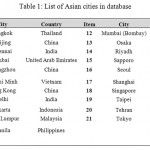 |
Table 1: List of Asian cities in database Click here to View table |
Sustainable transportation indicators development
An indicator is a variable based on some measurements, representing as accurately as possible a phenomenon of interest26. Indicators are variables selected and defined to measure progress toward an objective7. Chapter 40 of Agenda 21 states that ‘‘indicators of sustainable development need to be developed to provide solid bases for decision-makingat all levels and to contribute to a self-regulatory sustainability of integrated environment and development systems’’10OECD defined sustainable transportation indicators as statistical measures that give an indication of the sustainability of social, environmental and economical development26. There are some efforts to define indicators to quantify urban sustainable transportation. In some cases,STI’s were used and selected from urban sustainable development indicator set. Several authors note that indicator selection should primarily be driven by the questions that the indicators are supposed to answer26-29. Indicator should be easily understandable, reasonable, measurable, possible to quantify, accessible, comprehensive, reflect various aspect of study, sensitive to changes over time, independent, standardized for comparison, clearly defined and capture long-term processes27-30. Also Joumard et.al in chapter 4 of their recent research, introduce 10 criteria for indicator selection which were categorized in 3 main groups26.
- Representation: validity, reliability, sensitivity
- Operation: measurability, data availability, ethical concerns
- Policy application: transparency, interpretability, target relevance, action ability.
a) Transportation environmental impact indicator,TEII
TEII’s in MCDST are about urban transportation local emission, energy use and land consumption.Land consumption is defined as sum of urban land area allocated to road and public reserved line.
b) Transportation economical impact indicator, TCII
Economical indicators,TCII,are local government budget in transportation sector, time spent in traffic and user cost over GDP per capita.In this research, GDP per capita was selected instead of household’s costs.
c) Transportation social impact indicator, TSII
The social indicators, TSII,are transportation death per million people, accessibility and variety of transport option. The concept of accessibility has played a major role for several decades in the literature of regional and transport researches31.Definition and measures found in the transport literature can be categorized in 3 clusters: infrastructure related, activity related and mixed measures32. One known accessibility indicator is density of network in area or network length per area32. This indicator is the reverse of average distance of each urban point from system network and shows system accessibility. Network length per area can be measured for each transport system such as bus, rail and private mode,but the question to be investigated is how could various systems’ accessibility be aggregated and urban transport accessibility indicator be developed? The next term regarded to join in definition of various systems’ accessibility is passenger-km per capita traveled per network unit length. This term shows relative ability of network unit length of each system for carrying passenger. Therefore, transportation accessibility is defined as Equation 1:
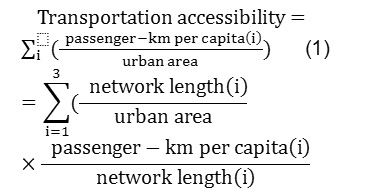
i:transportation systems(private transport, public transport and non motorized transport) This new indicator is more comprehensive, reasonable and easily measurable by the MCDST. Urban area as is defined by the MCDST is urbanized zone of the metropolitan area where farmland, forests and large green spaces are excluded24. Some research considered time or speed in definition of accessibility31,32. In this research time spent in traffic was considered as an economical indicator. In this paper, variety of transport option is redefined as distance of city modal share from a hypothetical city with equal public, private and non-motorized modal share.Redefinition of transport variety option is
shown as Equation 2:

According to the aim of this research for sustainable transportation evaluation between Asian cities, all above indicators are reasonable, transparent and measurable by the MCDST. The final indicators used for Asian city comparison based on MCDST database are shown in Table 2.
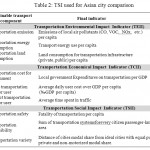 |
Table 2: TSI used for Asian city comparison Click here to View table |
Sustainable transport composite index
The finally collected STI’s are categorized in three groups: environmental, economical and social ones. For urban comparison it is necessary to build composite index to cover the 3 dimensions. The method used in this paper for building composite index is simply additive weighted method. In the first step, Z-score of all indicators are calculated as Equation3. Z-score is popular to normalize the indicator26,33. Then for each group a composite index is built by adding normalized indicators by regarding equal importance weight as shown in Equation 3 to 6. This is one of the approaches for multi-criteria decision analysis, MCDA, which the weights of objects assumed are the same26,33. Although weighted factor could be considered by indicator frequency of use in literature as shown in Table5 but it seemed not to be reasonable because some indicators were edited and redefined. In addition,some researchers have been influenced by others and their points of view weren’t independent. There are also some other methods for multi-objective evaluation26,34, however simple additive weighted method was appropriate for correlation analysis in this research between sustainable transport composite index and cities specifications. Sign “–“is used for indicator which the smaller amount of this in sustainable transport is better ,like emission, and Sign “+“ is used for indicator which larger amount is better, like access.
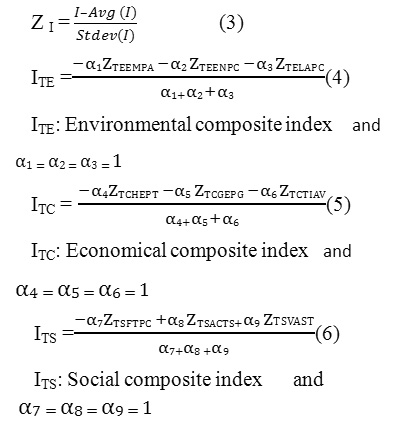
Overall sustainable transport composite index, IOST,was built by adding the result of normalized composite index based on Equation 7. In this research relative importance of all sustainable transport sectors of environmental, social and economical were assumed equal.
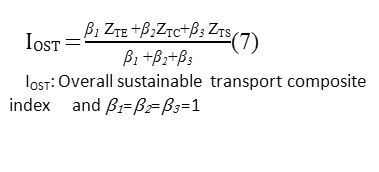
Results
Cities comparisonThe IOST was calculated for 21 cities from the database. Table 3 shows the sustainable transportation composite index IOST and its components,ITE,ITC,ITCfor the best and worst Asian cities and the rank of these cities were consequently identified. To find effective factors in urban transportation sustainability, the best and worst cities specification are shown in Table4.
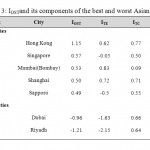 |
Table 3: IOSTand its components of the best and worst Asian cities Click here to View table |
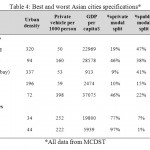 |
Table 4: Best and worst Asian cities specifications* Click here to View table |
Correlation analysis
The correlation coefficient between some specifications of all cities such as GDP, urban density, vehicle ownership, transportation modal share and sustainable transportation composite index IOST and its components, ITE, ITC,ITC were calculated and shown in Table 5.
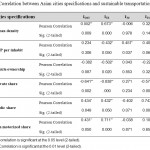 |
Table 5: Correlation between Asian cities specifications and sustainable transportation indexes Click here to View table |
Discussion
As the table 5 shows, despite the small sample size, a large number of relations are significant at the 0.05 level and it’s because of high correlation between variables. Although contents of tables3 and 4 are based on MCDST and may have changed in recent years but based on the assessment of IOST and its components, the important facts about urban sustainable transportation are summarized as:
- According to table3, three of five top sustainable Asian cities (Hong Kong, Shanghai, Sapporo) are from East Asia.The main reason for the success of East Asian cities is giving priority to public and non motorized transport. East Asian cities have respectable public transport operating speeds reflecting past investments in rail systems that now carry substantial proportions (30 percent or more) of public transport passenger kilometers. Hong Kong has built substantial rail mass transit system since 1970s but retain an important role for buses in mixed traffic.Because Shanghai’s per-capita road area was extremely low and the majority of its roads were narrow, traffic bottlenecks were numerous. For this reason, most of cyclist were captive user and in this study ITS because of low transport variety dropped. In the past, bicycle infrastructure was purposely neglected by Shanghai city officials in hopes that residents would ditch their bikes and opt for public transportation.Recently, an increasing reprioritization on sustainability, active transportation, and environmental awareness by Chinese cities has placed bicycles higher on the priority list. In Shanghai, some roads now have bike lanes and the city has even implemented free or low cost bike-sharing programs for residents.
- Correlation analysis shows that denser cities have the better IOST. They have also lower resources consumption and emission because of shorter trip distances.For example, Hong Kong and Mumbai concurrently are two of top three in the lists of urban density and IOST.Currently, over 88% of the commuters in Mumbai use public transport (suburban trains & buses). It is the most convenient, efficient and cheap form of transport to a population which is dense to such an extent.
- Cities with more private modal share have the worst ITE because of more energy use and emission. Also cities with more car dependency have worse transportation social indicator because of distance from equity share of trips. So,car dependent cities have lower IOST because of environmental and social impacts. In this database, Riyadh and Dubai have the highest private share and the worst IOST.In general, cities in the Middle East due to having nonrenewable fuel sources and accessing to cheap fuel are more car dependent and private transport is a priority for investment.
- GDP has positive correlation to sustainable transportation because of economical and social impacts but developed cities with high GDP should be aware about environmental impact. Although, Tokyo have the highest GDP in this database, but hasn’t high rank in IOST and it is because of environmental impact.
- In general, growth of vehicle ownership has negative impact on urban environment and reduces IOST. As table 3 and 4 showed, Hong Kong has the lowest vehicle ownership and highest IOST score.
- Developing cities such as Mumbai have acceptable ITE because of the lowest car ownership. There is the possibility of ITE andIOST to deteriorate in future by increase in car ownership.Developing city’s transport policy makers must be aware of disadvantages of private modal share growth in their developing process. Three aspects of sustainable development should also be balanced.
Conclusion
In this research, sustainable transport indicators for ranking and identification of sustainable and unsustainable Asian cities have been applied. Comparative analysis shows that East Asian and Middle East Asian cities have highest and lowest sustainable transportation index, respectively. As correlation analysis showed, concentrating on public and non motorized transport development improves urban sustainability. In other hand, while vehicle ownership and private share increase, urban sustainability deteriorates, respectively. However, the urban transport situation has changed drastically, but the research could be useful in ranking, examination of feedback and extraction of key factors in future studies.Acknowledgements
The authors wish to thank the Sharif University of Technology for providing partial funding for this study.
References
- Wright L., Environmentally Sustainable Transport for Asian Cities: A Sourcebook, United Nations Centre for Regional Development (UNCRD), Nagoya, Japan: 1 (2010)
- UNCRD (United Nations Center for Regional Development), Annual Report 2008/2009, Nagoya, Japan, 7 (2010).
- UNCRD (United Nations Center for Regional Development), Annual Report 2010/2011, Nagoya, Japan: 11 (2010).
- Quaddus, M.A., Siddique, M.A.B, Modeling sustainable development planning: A multi criteria decision conferencing approach, Environment International 27, 89–95 (2001).
- WCED (World Commission on Environment and Development), 1987, Ourcommon future. Oxford University press.
- Krajnc D., Glaviˇc P., A model for integrated assessment of sustainable development, Resources, Conservation and Recycling 43, 189–208 (2005)
- Litman T., Sustainable transportation indicators, Sustainable Transportation Indicators Subcommittee of the Transportation Research Board: (2008).
- Tanguay A., Lefebvre J.F., Lanoie, P. Measuring the sustainability of cities: An analysis of the use of local indicators, Ecological Indicators 10, 407–418 (2010).
- Gilbert, R., Irwin, N., Hollingworth, B., Sustainable Transportation Performance Indicators (STPI), Transportation Research Board (TRB), CD ROM: (2003)
- United Nations, Agenda 21: The United Nations Programmer of Action from Rio. United Nations, New York: (1992)
- Schipper L., Shiuen W., Huizenga C, 2006, Sustainable Transport Development in Three Medium Sized Asian Cities, TRB Annual Meeting, 3 (2007).
- Asian Development Bank, 2001, Urban Indicators for Managing Cities, Manila, Philippines.
- Onogawa K, The UNCRD Asian EST Initiative, Global Forum on Transport and Environment in a Globalising World, Guadalajara, Mexico: 3 (2008).
- Barter, P., Kenworthy,J. and Laube, F. Lessons from Asia on Sustainable Urban Transport, in Low, N.P. and Gleeson, B.J (eds .) Making Urban Transport Sustainable,Basingstok e UK: Palgrave-Macmillan: 6 (2003).
- Savage V., December, Ecology matters: sustainable development in Southeast Asia, Integrated Research System for Sustainability Science and Springer: 37-63(2006).
- World Bank, cities on the move, Washington, D. C: 101 (2002).
- Haghshenas H., Vaziri M., Urban sustainable transportation indicators for global comparison, Ecological Indicators 15: 115–121 (2012).
- Haghshenas H., Vaziri M., Sustainable Transportation Policy Development Using System, TRB 2013 Annual Meeting, (2013).
- World Bank, Sustainable Transport Priorities for Policy Reform, Washington, D. C.
- Appleton B., Davies M., 2008, SMART transportation ranking report, Green Apple Canada.
- Hezri, A.A, Hasan, M. N., 2004, Management framework for sustainable development indicators in the State of Selangor, Malaysia, Ecological Indicators 4, 287–304.
- United Nations Habitat,2004, Global Urban Observatory and Statistics, www.unhabitat.org.
- Jane’s Urban Transport Systems 2006–2007, Clarke j, Jane’s Information Group, 2006.Jeon C., Amekudzi A., 2005,Addressing sustainability in transportation
- UITP, International Association of Public Transport, “Millennium cities database for sustainable mobility”, 2001.
- UITP, International Association of Public Transport, “Mobility in cities database”,2006.
- Joumard R.,Gudmundsson H., Editors, 2010,Indicators of environmental sustainability in transport, ©Les collections de l’INRETS
- Zhang., Y, Guindon, B., Using satellite remote sensing to survey transport-relatedurbansustainabilityPart 1: Methodologies for indicator quantification, International Journal of Applied Earth ObservationandGeoinformation 8,149–164 (2006).
- Li F., Liu X., Hu D.,WangR.,Yang W.,Measurement indicators and an evaluation approach for assessing urbansustainable development: A case study for China’s JiningCity,Landscape and Urban Planning 90, 134–142(2009).
- Litman T., Sustainable transportation indicator data quality and availability, Victoria Transport Policy Institute (2009).
- Nourry M., Measuring sustainable development: Some empirical evidence for France from eight alternative indicators, Ecological Economics 67, 441 – 456 (2008).
- Condeço-Melhorado A., Gutiérrez J.,Garcia-PalomaresJ. C., Spatial impacts of road pricing: Accessibility, regional spillovers and territorial cohesion, Transportation Research Part A 45: 185–203 (2011)
- Wee, B.V., Hagroot, M., Annema J. A., Accessibility measures with competition, Journal of Transport Geography 9: 199-208 (2001)
- Rassafi, A., Vaziri, M., Assessment of modal transportation sustainability: Application of data envelopment and concordance analyses. Iranian Journal of Science & Technology, © Shiraz University Transaction B, Engineering 31:179–193 (2007).
- Hwang C.,"MultyAtribute Decision makimg methods and application", Springer-Verlay-Berlin (1981).







